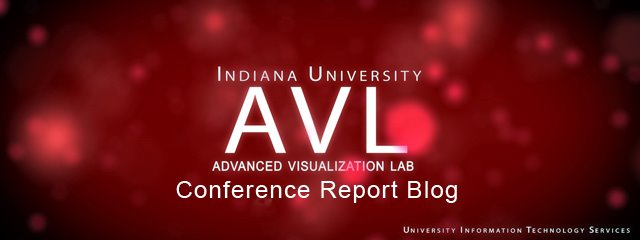IEEE VR 2009 - Mike's Thoughts
Sunday, March 15, 2009 - I spent the whole day in the 3D UI sessions. Overall I found the material very interesting. The best paper award went to Arch-Explore. The best poster award went to a woman from George Mason who had an application using the Phantom to train ADD kids to do handwriting tasks (but the poster was taken down before I had a chance to see it; I’ll check the proceedings when I can).
Of particular interest was the keynote talk by the Director of Autodesk research. He spoke to the concept of making UI “fun” – that is the missing ingredient. He references this through the joy of physically building things. He wants to consider combining virtual and physical objects. These combinations could be the key to the next great UI. He presented a bunch of ideas related to real-world technologies that might enable this: multi-touch, 3D printing, 3D scanner (he called it 3D sampling), and real deformable materials.
Examples worth looking up include:
· This guy really liked multi-touch. He didn’t say too much other than he thinks it is the next big thing for UI.
· The life-size Chopper (the motorcycle). This started as an Inventory digital model and ended up being the hit of the Autodesk customer center. It is a life-size replica created through 3D printing (and pieced together very carefully). He had video of people sitting on it. I think he said Stratus (is that correct?) was the printing company.
· Contour crafting (3D printing with concrete to build large structures like houses).
· Check out the BMW future car that uses deformable materials. It was unbelievable. Dave and I had lunch with some folks from UCF and none of us have ever seen anything like that.
· Autodesk’s PenLight prototype (AR meets the Perceptable for blueprints). It will be presented at SIGCHI next month.
I also listened to Margaret Dolinsky present some of her thoughts on perception for immersive environments. It was really good to hear her talk about her own work. I think everyone in our group should hear her perspective in a more formal setting. And, of course, it's always good to hear "Indiana University" from a speaker (especially when the room is packed; it was standing room only, literally).
Sunday, March 15, 2009
Thursday, March 12, 2009
IEEE VR 2009 - Chauncey's Report

DAY 1:
So I spent the Day in discussion with "SEARIS" and other software engineers and actually found myself enlightened. Being a high level end user who programs maybe 5% of time during my professional work loads I still understood and contributed to this discussion.
The summery of what we talked about during the workshop was as fallows:
- There are TONS of VR&AR toolKits out there
- Non of them have taken any big leaps in 15 years
- They only add features, are adapted to new hardware, or are reinvented the same!
- Higher Level development software is needed for VR&AR because its still daunting for end users
- Since VR/AR digitally requires or spans SO MUCH in hardware IO a new approach should be adopted
- The suggestions were to create the software as an AI model (image below of simple AI model)

- Ofcourse I have no idea how to actually make this , but thats not the point. For example look at the adobe suite it is a VERY high level of programming, but its easy for non-programmer end users to develop complex content with.
- The reason for this is the huge demand for what adobe's software does. Now VR finally now has that demand and its time.
-Virtools was mentioned and used as a good starting point, but since its commercial and not open source it won't be affected by our discussion you just have to ask and hope with the private commercial developers.
My personal 2 cents:
I finally understand how these ambiguious AR toolkits are used and realize that they are ambiguious for all end users. I just thought I was missing the boat on it all. SEARIS is not concerned with application speed as a high priority and as a group of developers I like this because hardware will eventually catch up. Anyway it was a neat day-in-a-developer's shoes type day, and I wouldn't want their job, but I am excited that they care about the end users.
Also I am going to give this GUI a try it has a lot of toutorials on their website and will parallel with all VR GUIs I think just for my own knowledge. One of the develpers spoke on it today.
Here is my tenative schedule:
SUNDAY:
- Workshop 1 (SEARIS)
- 8:30am - 5:30pm
SUNDAY:
- Toutorial 4 (Conducting Human Subject Experiments with Virtual and Augmented Reality)
- 8:30am - 5:30pm
MONDAY:
- Session 1: Haptics & interaction
-9am-10:30am
- Panel: VR and Art: Hyper-Reality?
- 11am-12:30pm
- Exibit floor & Research Demos
- 1:30pm - 3:30pm
- Session 3: Augmented Reality
- 3:45pm - 5:30pm
- Poster Session & LITE Reception
- 5:40pm - 8:30pm
TUESDAY:
- Keynote Address
- 8:30am - 10:30am
- Exibit Floor & Research Demos
- 10am - 3:45pm
-Session 6 Eye Gaze & Olfactory Displays
- 3:45pm - 5:30pm
Subscribe to:
Posts (Atom)
